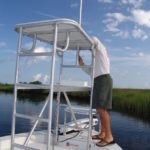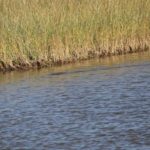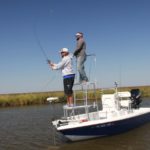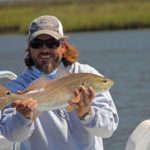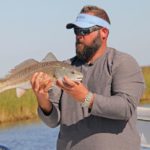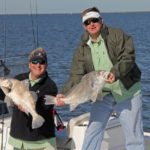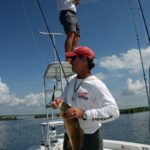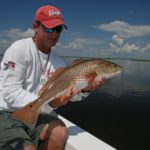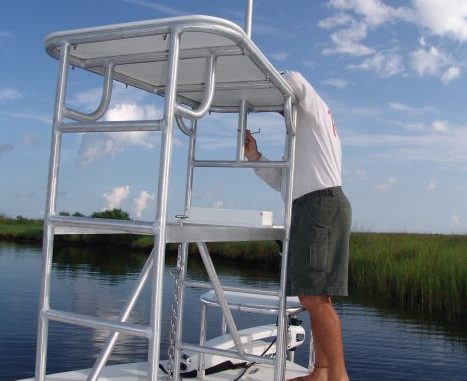
Elevated positions afford redfish anglers optimal vision and response.
The prominent V wake was unmistakable, even from my camera boat positioned 50 feet from the anglers working a grass line.
Capt. Travis Holeman spotted this easy target well before I did and he also spotted a lot of subtle ones that I simply would not have seen — even if our boats had sat abreast to one another.
Based in Florida, Holeman spends several months each year guiding the East Delta marshes, so his is a keen eye for muddy-water activity. Nevertheless, he and his brother/inshore tournament partner, Bryan “Bear” Holeman, reaped the rewards of an indispensible inshore asset. Their difference-maker was the elevated perch from which they were scanning the Hopedale marsh.
Competing in the Saltwater Series Big Fish Challenge — a bragging-rights event staged by the Outdoor Channel — the Holemans were dealing with post-frontal conditions and noticeably lethargic fish. Needless to say, they had to make the most of every opportunity, and that meant capitalizing on each fish that came within casting range. Such conditions, Travis said, exemplify the value of fishing upstairs.
“In Louisiana when you’re on them, you’re really on them,” he said. “But on those days when you only see a couple dozen fish, a tower gives you a shot at catching each one you see because of the extra time you get from your elevated fishing position.”
Also competing in the tournament were Capt. Charlie Thomason, whose Silver Sides Lodge hosted the event, and his partner Keith Hartsell. The duo ended up winning the tournament on the strength of their huge cumulative weight comprised almost solely of black drum. A sight-fishing platform fastened to their bow also factored greatly into their success.
Tower specs
Travis Holeman is quick to clarify the difference in a towerboat and a boat with a tower, or elevated platform, on its bow. For him, it’s all about fishing from an elevated position, but driving with “feet on the floor.” In a pinch, a fiberglass ladder will get you some needed altitude, but today’s marine fabricators can assemble specialized fishing structures to fit a broad range of specifications.
The Holeman brothers have rigged their 22-foot bay boat with a specialized tower that suits their style of fishing — two brothers (one of whom is no small fellow) simultaneously elevated.
Built by Texas-based Custom Marine Concepts, the Holemans’ bi-level tower features step-style platforms of 28 and 50 inches with a removable rear safety bar and a frame that leaves all hatches fully accessible.
Travis said a custom tower should be built for flexibility and storage between sight-fishing trips. If his day calls for fishing jetties, rigs or open water, his tower’s off and stored in five minutes.
When choosing or designing a tower or casting platform for your inshore boat, start by identifying the basic parameters of how you’ll use the structure. Will you fish alone on the bow, or will an angling partner join you? Do you prefer side-by-side positions, or bi-level? How many rod holders do you need and where do you want them positioned?
“The rod holders (on my tower) are placed so it can double as a conventional or fly platform,” Travis said of the latter consideration. “Sixty percent of my fishing is with (a fly rod) so it’s important to have no line catches on any apparatus attached to my boat.”
Travis Holeman also advised these considerations: “First, I’d use agility as the defining factor for design. The young and agile can use minimal towers with vertical steps, but as age catches up and comfort becomes more important, I’d recommend what I like to call ‘a stairway to heaven.’ I like a big, wide and easy on-and-off design with a full aluminum safety wrap. You don’t want to fall off, and it sure is nice to add a seat for the longer days.”
Tower time
Travis Holeman said the casting tower makes sense any time whenever sight fishing is the order of the day. For him and his brother, that’s pretty much all the time.
“Sight fishing is more hunting than fishing and, personally, it’s a much more gratifying method of putting fish in the boat,” he said.
Holeman said the tower benefit comes down to mathematics — angles, specifically. When you’re standing flat on a boat’s deck, the line from your eyes to the water ends at a certain angle. When you climb into a tower, that line extends and the angle opens significantly. The net gain is a vastly greater area into which you can view, rather than across the water. Pair that advantage with a sun-shading hat and polarized glasses, and the fish have a hard time sneaking past you.
“The elevated fishing position adds about 20 feet more visibility away from the boat for every foot you (ascend),” he explained. “With today’s tackle, even at an elevated casting/fishing position, you can reach almost every fish you see if you commit to developing your Zorro-like skills with either a bait or spinning rod. I use a baitcaster for better line and lure control for both short and long casts.”
Consider the advantages of an elevated perspective. How often do anglers standing flat on the bow round a grassy point and wince at that telltale mud cloud we often call a “dust-off” or “smoke.” Wish you would’ve seen the fish in time? Most do, but if you had been able to peek over and around that corner before the pressure of your boat wake spooked the fish, you could have adjusted your course and/or speed and positioned yourself for the right cast.
And what about water clarity? After the Saltwater Series event, Bryan Holeman noted his team’s dependence on the clean water falling out of the marsh. Noting that the clean water formed a zone of higher visibility near that marsh edge, he said their tower positions enabled him and his brother to peer far down the line to see what this high-vis area held.
No doubt, the sight-fishing advantage paints with a broad brush, but in fairness, a tower doesn’t fit every shallow-water scenario. As Travis Holeman explains, it comes down to quality versus quantity.
“Most trout fishing trips are with a boat load of friends, and this is one trip that a tower is not recommended,” he said. “All the advantages of fishing from an elevated position become obstacles for casting and moving around on the boat.”
Tower tactics
The Holemans often take turns at the high and low positions, but they’re collective experience and angling skill works well regardless of individual duty. For others, Travis said a bi-level fishing platform offers two options for anglers with varying skill levels.
“The lower station is for the more accurate short caster and the top station is for the long caster or the prospector,” he said. “Some people have to blind cast, and that person can cover a ton of water from the top and still not get in the way of the committed sight fisherman on the lower station. Conversely, if it’s overcast, the lower angler can blind cast and the top angler sight fish, as the elevated fishing position affords them much more visibility.”
Clearly, the bottom line motivation for outfitting a boat with a casting tower is the ability to find and reach more fish. However, that hunting analog that Travis Holeman used makes a nice point of conclusion. A lot of deer, hogs and varmints are shot by hunters on the stalk. However, a lot more fall to those who set up shop inside a blind or up in a tree. The same strategy applies to sight fishing. An active, stalking approach is certainly part of the game, but to maximize the benefits of that elevated perspective, you have to know when to hit the brakes.
“If I’m fishing spooky fish, we won’t be moving toward them — we’ll choose a more productive ambush point to fish from,” Travis Holeman said. “Stealth is achieved by figuring out your prey and stalking them. You never chase them, unless they are in a schooling rampage and eating everything in sight. Slowing down also makes it less likely for the anglers to miss an opportunity.”
Thomason and Hartsell employed this principle while spending most of their final day in the Lake Calabasse area. Armed with medium-heavy baitcasting outfits spooled with 30- and 50-pound braid and 30-pound fluorocarbon leaders, they worked depths of 2-3 feet with live shrimp on 3/8-ounce jigheads. The key, Hartsell said, was a stealthy approach and long periods of watching from their bow perch. Big schools of drum were grazing throughout the warm shallows, and spotting those patches of nervous water was the key to zeroing in on the fish.
“We came in from behind with the wind at our backs and just tried to slowly sneak up on them,” Hartsell said. “Once we located them, we made sure we didn’t get too close and push the school away.
“Charlie did a good job of trolling up behind the school, and once we saw the first mud, we put the PowerPole down and we were able to whack away at them.”
Some final thoughts: A tower or casting platform should never impede your boat’s performance or jeopardize its stability. Similarly, make sure the structure does not obstruct your visibility (larger platforms can be designed with fold-down sections). Consider also that your elevated position will increase the distance from your trolling motor, so invest in a remote control or add an extension handle for control from above.
